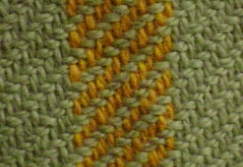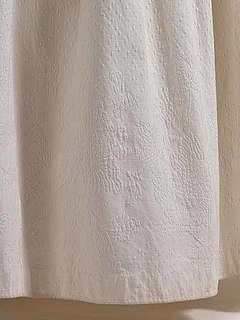
Duct tape, also called duck tape, is cloth- or scrim-backed pressure-sensitive tape, often coated with polyethylene. There are a variety of constructions using different backings and adhesives, and the term 'duct tape' is often used to refer to all sorts of different cloth tapes of differing purposes. Duct tape is often confused with gaffer tape. Another variation is heat-resistant foil duct tape useful for sealing heating and cooling ducts, produced because standard duct tape fails quickly when used on heating ducts. Duct tape is generally silvery gray, but also available in other colors and even printed designs.
A whipping knot or whipping is a binding of marline twine or whipcord around the end of a rope to prevent its natural tendency to fray. The whipping can be made neat and permanent by tying it off or sewing the ends of the twine through the rope. According to The Ashley Book of Knots, "The purpose of a whipping is to prevent the end of a rope from fraying...A whipping should be, in width, about equal to the diameter of the rope on which it is put...[Two sailmaker's whippings], a short distance apart, are put in the ends of every reef point, where the constant "whipping" against the sail makes the wear excessive; this is said to be the source of the name whipping." The other type of stopping knot is a seizing knot.
Alesis Digital Audio Tape (ADAT) is a magnetic tape format used for the recording of eight digital audio tracks onto a Super VHS tape that is used by consumer VCRs.

Gabardine is a tough, tightly woven fabric used to make suits, overcoats, trousers, uniforms, windbreakers and other garments.

Twill is a type of textile weave with a pattern of diagonal parallel ribs. It is one of three fundamental types of textile weaves along with plain weave and satin. It is made by passing the weft thread over one or more warp threads then under two or more warp threads and so on, with a "step," or offset, between rows to create the characteristic diagonal pattern. Because of this structure, twill generally drapes well.
Whipcord is the name for either a fabric or a form of braided cord.

D-VHS is a digital video recording format developed by JVC, in collaboration with Hitachi, Matsushita, and Philips. The "D" in D-VHS originally stood for "Data", but JVC renamed the format as "Digital VHS". Released in 1998, It uses the same physical cassette format and recording mechanism as S-VHS, and is capable of recording and displaying both standard-definition and high-definition content. The content data format is in MPEG transport stream, the same data format used for most digital television applications. The format was introduced in 1998.

Fairchild TV or FTV is a Canadian Cantonese language exempt specialty channel. It is owned by Fairchild Group, with Hong Kong broadcaster TVB holding a 20% minority stake. Fairchild TV has studios in the Greater Toronto Area and Greater Vancouver.

A cable tie is a type of fastener, for holding items together, primarily electrical cables or wires. Because of their low cost and ease of use, cable ties are ubiquitous, finding use in a wide range of other applications. Stainless steel versions, either naked or coated with a rugged plastic, cater for exterior applications and hazardous environments.

Piqué, or marcella, refers to a weaving style, normally used with cotton yarn, which is characterized by raised parallel cords or geometric designs in the fabric. Piqué fabrics vary from semi-sheer dimity to heavy weight waffle cloth. Twilled cotton and corded cotton are close relatives.

Tweed is a rough, woolen fabric, of a soft, open, flexible texture, resembling cheviot or homespun, but more closely woven. It is usually woven with a plain weave, twill or herringbone structure. Colour effects in the yarn may be obtained by mixing dyed wool before it is spun.

Broadcloth is a dense, plain woven cloth, historically made of wool. The defining characteristic of Broadcloth is not its finished width, but the fact that it was woven much wider and then heavily milled in order to shrink it to the required width. The effect of the milling process is to draw the yarns much closer together than could be achieved in the loom and allow the individual fibres of the wool to bind together in a felting process. This results in a dense, blind face cloth with a stiff drape which is highly weather-resistant, hard wearing and capable of taking a cut edge without the need for being hemmed.

A fish tape is a tool used by electricians to route new wiring through walls and electrical conduit.
The manufacture of textiles is one of the oldest of human technologies. To make textiles, the first requirement is a source of fibre from which a yarn can be made, primarily by spinning. The yarn is processed by knitting or weaving, which turns yarn into cloth. The machine used for weaving is the loom. For decoration, the process of colouring yarn or the finished material is dyeing. For more information of the various steps, see textile manufacturing.

Cable lacing is a method for tying wiring harnesses and cable looms, traditionally used in telecommunication, naval, and aerospace applications. This old cable management technique, taught to generations of linemen, is still used in some modern applications since it does not create obstructions along the length of the cable, avoiding the handling problems of cables groomed by plastic or hook-and-loop cable ties.

The sampot, a long, rectangular cloth worn around the lower body, is a traditional dress in Cambodia. It can be draped and folded in several different ways. The traditional dress is similar to the dhoti of Southern Asia. It is also worn in the neighboring countries of Laos and Thailand where it is known as pha nung.

A foulard is a lightweight fabric, either twill or plain-woven, made of silk or a mix of silk and cotton. Foulards usually have a small printed design of various colors. Foulard can also refer by metonymy to articles of clothing, such as scarves and neckties, made from this fabric. In men's ties, foulard refers to the pattern rather than the material; it is a small-scale pattern with basic block repeat, also called a set pattern or a tailored pattern.
Tape or Tapes may refer to:

Herringbone, also called broken twill weave, describes a distinctive V-shaped weaving pattern usually found in twill fabric. It is distinguished from a plain chevron by the break at reversal, which makes it resemble a broken zigzag or the bones of a fish such as a herring. The pattern is called herringbone because it resembles the skeleton of a herring fish. Herringbone-patterned fabric is usually wool, and is one of the most popular cloths used for suits and outerwear. Tweed cloth is often woven with a herringbone pattern.
Sewing is the craft of fastening or attaching objects using stitches made with needle and thread. Sewing is one of the oldest of the textile arts, arising the in Paleolithic Era. Although usually associated with clothing and household linens, sewing is used in a variety of crafts and industries, including shoemaking, upholstery, sailmaking, bookbinding and the manufacturing of some kinds of sporting goods. Sewing is the fundamental process underlying a variety of textile arts and crafts, including embroidery, tapestry, quilting, appliqué and patchwork.














